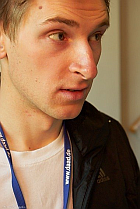M.Sc. Roman Vlasov
 M.Sc. Roman Vlasov
M.Sc. Roman Vlasov
Leibniz Universität Hannover
Institut für Mensch-Maschine Kommunikation
Fachgebiet Graphische Datenverarbeitung - Welfenlab
Welfengarten 1
30167 Hannover
Telefon | +49 (0) 511 762-2913 |
Fax | +49 (0) 511 762-2911 |
Resume
Roman Vlasov was born in Saint-Petersburg, Russia. He studied Applied Mathematics and Computer Science at Saint-Petersburg State Polytechnical University and got the Master degree in 2009. Since September 2009 he has the DAAD scholarship in the bounds of the Siemens/DAAD Postgraduate Programm and is the PhD student at Welfenlab, Leibniz Universität Hannover, Germany. His research topics are haptic rendering of medical data and visualization of the voxel data (direct volume rendering).
See the sections below for details about his studies, work experience and current research.
In case of any questions you can kindly contact him via phone or by e-mail. Normally he answers to an e-mail at the same day.
Work details
2009.09-now
Welfenlab, Leibniz Universität Hannover (Germany) — Researcher and Java (incl. Java3D), C++ programmer/Software Engineer
Projects:
– PhD (the project is developed on YaDiV platform)
Winter Semester 2010/2011
Leibniz Universität Hannover (Germany) — lecturer in seminar (exercise) "Data structures and algorithms"
Research details
Roman Vlasov's research topics are haptic rendering of medical data and visualization of the voxel data (direct volume rendering).
But what is haptic rendering? There exist haptic devices. Such a device adds a new "dimension" to the simulation framework: the feeling of objects. Using the device a user can both manipulate an object and feel a force feedback reactions accordingly to the object manipulation in a virtual world. Haptic rendering is the process of computing and generating forces in response to user interactions.
The intension of the PhD research of Roman Vlasov is to develop a Virtual Reality (VR) system with a haptic interface to assemble a fractured bone. The system is based on the novel haptic rendering method for medical data. A typical use case would be, for example, pre-surgical planning of an operation for a patient with a splintered fracture. The general research problems are that the update rate of 1000 Hz for haptic rendering should be achieved and that there is a huge amount of volumetric data per object. Stability and synchronization issues should also be taken into account.
As far as source medical data is volumetric (represented by voxels), it should be effectively visualized and have high quality of resulting picture, to give the user better visual feedback and overall VR system impression. These topics are in the second scope of interest of the Roman Vlasov's reseach.
The PhD project is developed on YaDiV platform, which was created at Welfenlab in the past years.
Study details
2009–now – PhD student at Welfenlab, Leibniz Universität Hannover, Germany
2007–2009 – Master in Applied Mathematics & Computer Science at Saint-Petersburg State Polytechnical University (Russia), thesis: "Triangulated mesh simplification and its enhancements"
2003–2007 – Bachelor in Applied Mathematics & Computer Science at Saint-Petersburg State Polytechnical University (Russia), thesis: “Enhanced developable-triangulated-surface-to-plain mapping method and its applications“ [Surface flattening]
2001–2003 – Physical and Mathematical Lyceum 239 (Saint-Petersburg, Russia)

